[Note: This post has many pictures; if they don't all load, simply refresh your browser or right click on the spot where the picture should be and select show picture.]
Okay, so you probably looked at the title of this post and figured that it was going to be some sort of political post. If you were hoping that was what this post was about, I’m afraid you’re going to be disappointed.
Mom and I decided to go on one final southeastern Georgia adventure before I left for Korea, and after considering several options, we decided to make for Liberty County. You’re probably wondering where Liberty County is, what’s there, and why we chose such a place to spend my last Saturday in the States. Well, it had a lot to do with a slick new brochure we pricked up recently, which advertised the Historic Liberty Trail - a driving tour between ten different historic sites within the county. After reading the brochure, we decided to go. (www.libertytrail.com) We didn’t have time to go to all ten sites, so we chose the four which appeared most promising, along with two others as backup plans. The Liberty Trail was well marked with large signs, so we didn’t have any trouble finding our way, although we did have troubles of another kind, as you shall see.
Our first stop was the Cay Creek Wetlands, which sadly was closed. Granted, after pulling out our brochure and perusing it closely, we discovered that it said the place was only open Monday through Friday. While we both thought that was somewhat of an odd schedule, considering people often like to stop at such parks on weekends, but that’s their choice. We did, however, notice that it looked as though no one had entered the facility in ages; the park’s driveway was quite in need of a mow, and its grass had obviously not been driven over in a long time. Not exactly the most auspicious of starts.
From the Cay Creek Wetlands we followed the Liberty Trail signs into the town of Midway in order to visit the historic Midway Church and the museum. The museum was housed in a cute little house, built in the 1950s in a replica of the traditional style of the area. (As all of the plantation homes in the area were destroyed during Sherman’s march to the sea during the Civil War, there was no *actual* period home available to house the museum.) The museum was small, but quite nice and full of antiques from the 18th and 19th centuries, and we were given a guided tour by the museum’s docent. She gave us the key to open the nearby Midway Church, which was built in 1792 (the original church on the site, built in 1756, was destroyed during the American Revolution). The church key was unbelievably huge (a replica of the original key, which is on display in the museum), and a bit tricky to work. It was a nice enough church inside, although after a year in Russia, where cathedrals are smothered in frescoes, mosaics and gold iconostases, and where the oldest cathedral in the town in which I lived dated from the 12th century, 18th century waspy churches don’t really do much for me. An interesting fact: Sherman and his officers stayed within the church when they occupied the city of Midway, and they used the walled cemetery across the street for corralling livestock.
Mom and I decided to go on one final southeastern Georgia adventure before I left for Korea, and after considering several options, we decided to make for Liberty County. You’re probably wondering where Liberty County is, what’s there, and why we chose such a place to spend my last Saturday in the States. Well, it had a lot to do with a slick new brochure we pricked up recently, which advertised the Historic Liberty Trail - a driving tour between ten different historic sites within the county. After reading the brochure, we decided to go. (www.libertytrail.com) We didn’t have time to go to all ten sites, so we chose the four which appeared most promising, along with two others as backup plans. The Liberty Trail was well marked with large signs, so we didn’t have any trouble finding our way, although we did have troubles of another kind, as you shall see.
Our first stop was the Cay Creek Wetlands, which sadly was closed. Granted, after pulling out our brochure and perusing it closely, we discovered that it said the place was only open Monday through Friday. While we both thought that was somewhat of an odd schedule, considering people often like to stop at such parks on weekends, but that’s their choice. We did, however, notice that it looked as though no one had entered the facility in ages; the park’s driveway was quite in need of a mow, and its grass had obviously not been driven over in a long time. Not exactly the most auspicious of starts.
From the Cay Creek Wetlands we followed the Liberty Trail signs into the town of Midway in order to visit the historic Midway Church and the museum. The museum was housed in a cute little house, built in the 1950s in a replica of the traditional style of the area. (As all of the plantation homes in the area were destroyed during Sherman’s march to the sea during the Civil War, there was no *actual* period home available to house the museum.) The museum was small, but quite nice and full of antiques from the 18th and 19th centuries, and we were given a guided tour by the museum’s docent. She gave us the key to open the nearby Midway Church, which was built in 1792 (the original church on the site, built in 1756, was destroyed during the American Revolution). The church key was unbelievably huge (a replica of the original key, which is on display in the museum), and a bit tricky to work. It was a nice enough church inside, although after a year in Russia, where cathedrals are smothered in frescoes, mosaics and gold iconostases, and where the oldest cathedral in the town in which I lived dated from the 12th century, 18th century waspy churches don’t really do much for me. An interesting fact: Sherman and his officers stayed within the church when they occupied the city of Midway, and they used the walled cemetery across the street for corralling livestock.

Midway Church
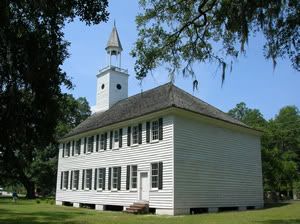
Midway Church

Isn't that key absurdly big?
When we were returning the key to the museum’s docent, an elderly woman came into the museum’s office. She apparently volunteers at the museum. She began talking to the docent - told her that she had walked the full six miles from her home into town this morning (by that time it was almost noon, the heat was topping 100F and the humidity was stifling) because her car was in the shop. The docent told her that she shouldn’t be out walking, not because the heat or because of her age, but “because there are some mean spirited people around here.” People who run little old ladies over for fun? Who knows!
My mom really wanted to visit the Melon Bluff Nature and Heritage Preserve, so that was our next stop. (Well, we stopped for lunch in between, but I figure you don’t really need an account of fried shrimp and onion rings!) After reading the description of Melon Bluff both in the brochure and on their website www.melonbluff.com, it sounded like a fantastic place to visit. Unfortunately, we arrived to discover that the gates to the property were locked! There was a sign on the gate which said “open Saturdays 10-4” so we decided to leave the car on the side of the road and walk in; it’s not like the place has to be open for a person to go hiking! But, the trail had obviously not been hiked in a while, and was constantly crisscrossed by huge and sticky webs bearing rather gargantuan spiders. (I’ve always referred to this type of spider as a banana spider, but recently I learned that they’re actually Golden Orb spiders. Either way, they creep me out. Not that the creep factor stopped me from photographing them or anything.) We walked a little way, but since we didn’t know anything about the trail (its length, where it went, etc) as my car was parked on the side of the road, and as there were creepy spiders all over the place, we decided to turn around. When we got back to the car, we noticed that under the place on the sign where it said “open Saturdays 10-4” it read “September through May” -whoops. There certainly wasn’t anything like that in our Liberty Trail brochure... and we were also confused as their website had stated that they offer kayaking trips and other excursions during the summer, so how could they be closed all summer? Puzzling.

This picture gives me the shivers.
Our next stop was Seabrook Village www.seabrookvillage.org, which was supposedly a living history museum based on a turn of the century African American community from the area. We followed the signs onward, and were directed into a gravel area labeled Seabrook Village Parking. It sat alongside a house - one which looked to be around the same age as mine. While there had been a sign on the road, there were no signs of any sort near this house, which looked suspiciously like someone’s home. Not wanting to go up an knock on some poor person’s door, we decided to drive on to see if we could locate any of the village (according to the brochure, the village consists of 104 acres and eight restored period buildings). While we did see what looked to be some old buildings on the opposite side of the road further down the highway, they were not labeled in any way. The Liberty Trail brochure stated that the Village was open Tuesday through Saturday, information which was confirmed in a Seabrook Village brochure we picked up at our next location. Yet where was this place?
So, we decided to keep driving down the road towards our first “backup” destination, the Fort Morris State Historic Site. At least it was open! We did have a moment of confusion when we pulled into the park; there were signs which read that one needed to pay a fee in order to park, yet there was no entry-fee kiosk. Luckily, it was just an oddly worded sign; entrance fees were accepted at the site’s museum. The site was nice (far more interesting than the Laura S. Walker State Park in Waycross!) although small. We learned about the fort, originally built to protect the pre-Revolutionary town of Sunbury (which at the time rivaled Savannah as a port city, although now nothing is left of the town except for the fort and the cemetery). The fort wasn’t all that successful in protecting Sunbury, as it was captured during the war and burned by the British. All that’s left of the fort are some earthen ramparts - again, not that exciting after having worked for a year a stone’s throw from a thousand year old earthen rampart, although there are some nice views of the surrounding marshlands. We learned from the park ranger (who was really cute!) that the buildings we had seen in the Seabrook area were indeed part of the mythical Seabrook Village, but he said that as it was a privately owned facility, he’d heard it didn’t have the funds to maintain regular hours.
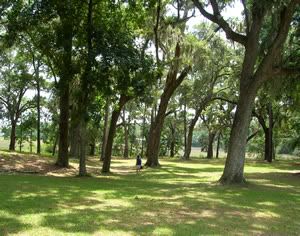
The site of Ft. Morris
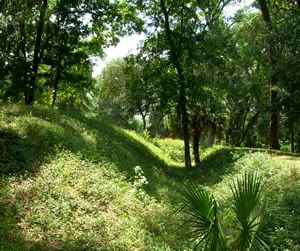
Ramparts of Ft. Morris
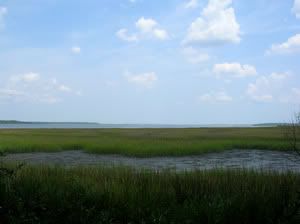
Marshland view
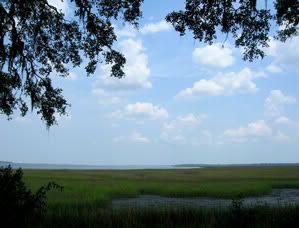
Another marshland view
From Fort Morris we drove to our last destination (er, second backup...) of the day, the Sunbury Cemetery. It holds graves dating back from the late 1700s, which was interesting, although it was oddly maintained. Fences had been erected around family plots in such a way as to obscure viewing of the faces of the stones. It almost looked as if the stones had been re-erected backwards, which was rather creepy.
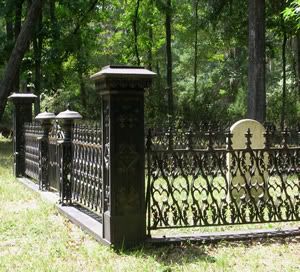
Sunbury Cemetery
We left the cemetery and began our drive back towards Midway. We hadn’t gone far when we saw what looked like an old brick gate-post. Now, the ranger had told us that nothing remained of Sunbury, but we decided to check it out anyway. We drove down to the water and discovered the remains of a terraced garden leading down to the river, where the remains of a dock and boathouse were located. There were also the burnt remains of the foundation of a home. From looking at the brickwork, we didn’t think it was too old; I thought 1960s, mom thought 1950s, although its location and the fact that it wasn’t labeled was intriguing. Then, as mom and I were still exploring, I saw a truck pull in. It drove towards where she was, and to be honest, I was quite tempted to hide. Anyway, it turned out to be the owner of the property, who was none too pleased to find us there, although he did tell us that the facility was constructed in the 1940s, and it had been his parents’ house, terraced garden and dock. It was only after we all drove away that I had a brilliant idea: The terraced garden area would not take much to fix up, and it would be a perfect place to hold weddings. I’m definitely not the sort of person who looks at things and thinks of marriage, but I’d bet that with a little work, that spot could easily be turned into a place that people would be more than willing to rent for weddings, reunions, etc.

A view of the property
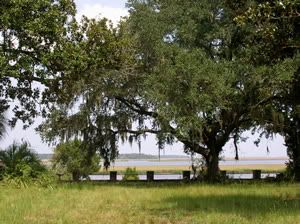
Another view
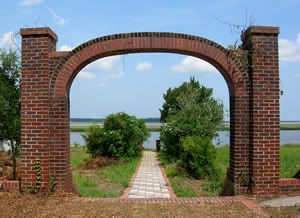
Archway in the middle of the terraced garden
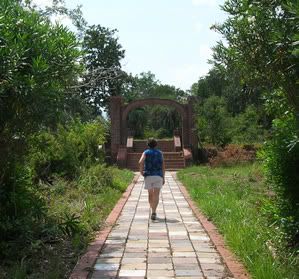
Looking back up towards the "house"

Their view was spectacular!
We were both a little unnerved by having been caught trespassing, and we were also tired and dripping with sweat (kind of grossly, actually), and were ready to go home at that point, but we decided - what the heck - we’d stop at the Seabrook Village buildings on the way back and see what, if anything, there was to see. The buildings on the opposite side of the road from the parking lot area were indeed the Seabrook Village facilities, although it definitely was not a “living history museum” while we were there! We saw an old one-room school house (the first school for African Americans in the area), and as it was unlocked, we were able to go inside and look around. From there we walked to an old house. There were signs in front of it that showed how the building had been painstakingly restored. The front door was locked, but the back door was not only unlocked, it was wide open! We did avail ourselves of this opportunity to look around, although we did shut the door behind us. Talk about a place just asking for trouble! The second house was at least locked. There was a large restaurant/pavilion/gift-shop area, although it was completely devoid of life. Next to the pavilion was an old train depot, obviously moved in from somewhere else. I definitely climbed inside (although the wood was kind of rotten...) - you know how I love my old train artifacts - although it was simply being used for storage, and unlike the other buildings, it had not been restored at all. We decided to check at the building next to the parking lot. While a close-up inspection did not reveal any signs or information about the village, it was obvious that the house was some sort of office facility, probably associated with the Village - but, of course, it was locked and empty. (Upon returning home and checking their website, we learned that currently they’re only open Tuesday through Thursday, and their target audience is school-kids. This explains why the place was deserted, although it doesn’t really explain the lack of signage and the unlocked buildings!)
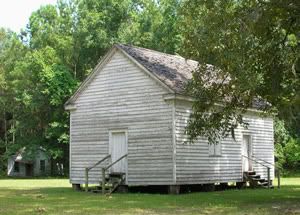
The one-room school-house
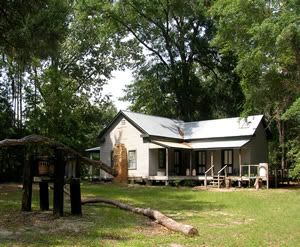
Restored Seabrook House
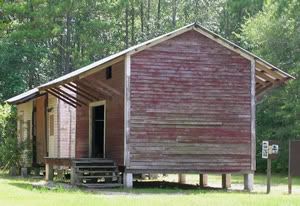
Old train depot
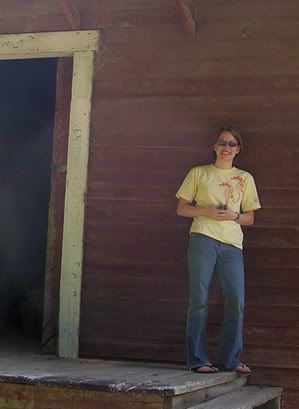
I await the Ghost Train
Yet again we set off for home, but as we approached the Melon Bluff Nature Preserve, we noticed that the gates were open and that about five cars were in the parking lot. So, we pulled in and knocked on the door. It was answered by a woman who looked quite confused to see us. Mom, who likes to go kayaking, asked for information about Melon Bluff’s kayak tours, and was told the best thing to do was to look online. Well, we’d already looked online, and thought we could find out more info by actually stopping by. Um, apparently not. In fact, the woman even said, “Well, I guess you could call the office and ask... but I work in the office and I bloody well can’t tell you anything about it!” Okaaaaaaay….. (Seriously, she said “bloody well”!) She also confirmed that the facilities were in fact closed during the summer, except for people who made reservations to come for special programs. Who the hell knows why she and her cronies were there. She also told us that Melon Bluff has another facility (“about two or three miles down the road”), which was only for guests. She said they shoot trespassers. She laughed to make it a joke, but still, it was strange. That and we’d just been (“about two or three miles down the road” and hadn’t seen anything labeled Melon Bluff. Bizarre.
That was the end of our bizarre series of adventures. The day didn’t exactly turn out anything like what we’d planned, although it misadventures certainly made it interesting. It almost felt like we were in the twilight zone or some sort of weird virtual universe where things only exist online and in brochures but not in reality...

No comments:
Post a Comment